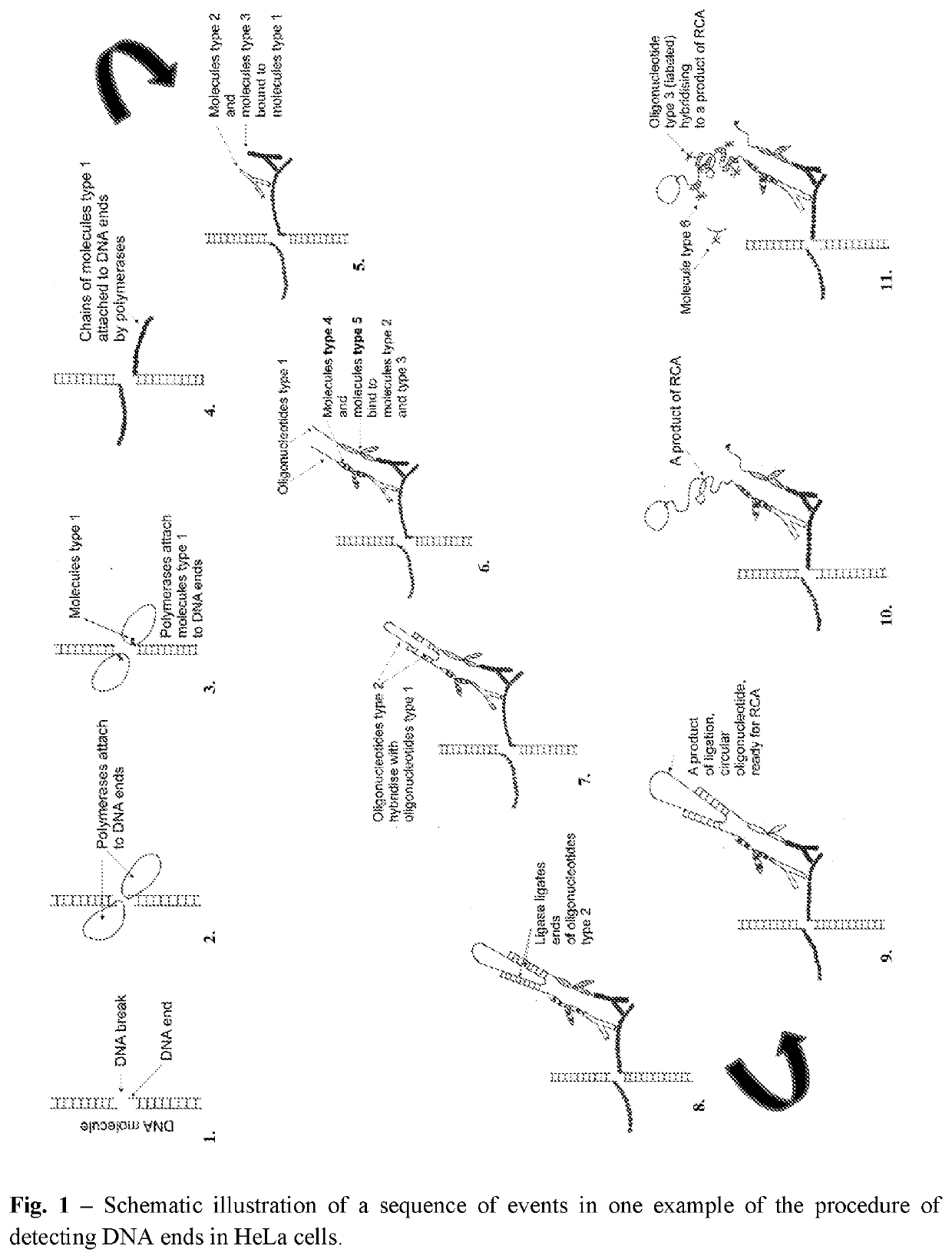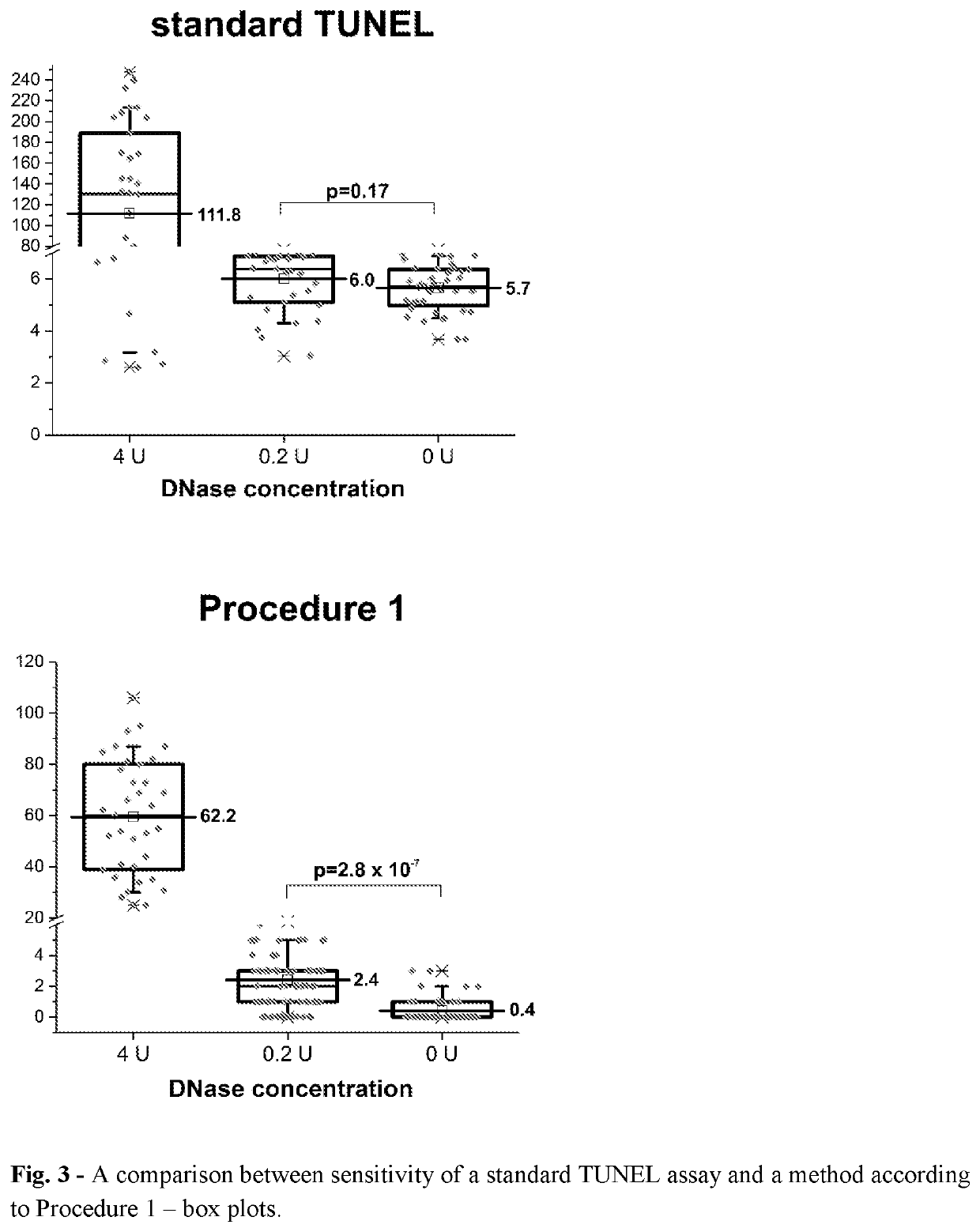Method of detection of DNA end(s) and its use
- Summary
- Abstract
- Description
- Claims
- Application Information
AI Technical Summary
Benefits of technology
Problems solved by technology
Method used
Image
Examples
example 1
[0370]Detection of Free DNA Ends in Untreated and DNase I Treated Fixed HeLa Cells Using the Method According to Procedure 1.
[0371]In this experiment HeLa 21-4 cells (obtained from P.R. Cook, University of Oxford) were used. Cells were seeded on 18-mm coverslips (number of cells: 0.2×106 per 1 coverslip) and cultured for 3 days in DMEM supplemented with 10% FBS. Subsequently, cells were incubated in 70% ethanol in water for 12 hours at −20° C. Then, cells were incubated in 0.5 mM EDTA in water for 30 minutes at room temperature. Before processing of DNA ends, some samples were treated with DNase I in order to induce DNA breaks. The reaction was performed in a droplet for 30 minutes at room temperature in a reaction mixture consisting of: 0.2 or 4 units of DNase I (Thermo Fisher Scientific, AM2222), 1× DNase I buffer (Thermo Fisher Scientific, AM8170G) and water. Subsequently, BrdU was linked to free ends of DNA using TdT enzyme using APO-BRDU kit (Phoenix Flow Systems, AU: 1001). Th...
example 2
[0381]Detection of Free DNA Ends in Untreated Fixed HeLa Cells Using the Method According to Procedure 2
[0382]In this experiment HeLa 21-4 cells (obtained from P.R. Cook, University of Oxford) were used. The cells were seeded on 18-mm coverslips (number of cells: 0.2×106 per 1 coverslip), cultured for 3 days in DMEM supplemented with 10% FBS and then incubated in 70% ethanol in water for 12 hours at −20° C. After that the samples were treated according to step 3 of Procedure 2 (blocking endogenous biotin) (Molecular Probes, Endogenous Biotin Blocking Kit, E-21390). Increasing of accessibility of DNA ends (step 4) was performed with 0.5 mM EDTA in water for 30 min at RT. To incorporate unmodified and modified biotin-conjugated nucleotides, cells were dipped in UltraPure Distilled Water (Invitrogen, Thermo Fisher Scientific, 10977-035) and then incubated (1 hour incubation at 37° C. in a humid chamber) with reaction mixture consisting of 1× NEBuffer2 (NEBiolabs, B7002S), 30 μM of each...
example 3
[0385]Detection of Free DNA Ends in Fixed HeLa Cells Using the Method According to Procedure 2—Evaluation of the Effect of Blocking Endogenous Biotin.
[0386]HeLa 21-4 cells were treated as in Example 2 but without step 3 (pre-blocking) from Procedure 2.
[0387]Results:
[0388]Free DNA ends, represented as bright fluorescent foci, were readily detected in untreated HeLa cells processed according to Procedure 2 (without step 3—blocking endogenous biotin) (FIG. 4., second row, left image). The average number of foci detected per one nucleus was 128±6 (N=24).
[0389]Conclusion (Example 2 and 3):
[0390]Slightly more free DNA ends were detected in samples processed according to Procedure 2 without blocking endogenous biotin (step 3) than in samples in which this step was present (128±6 vs 116±6). However, an independent two-sample t-test yielded a p-value=0.15, indicating that the difference between these two samples is not statistically significant. Thus, one can conclude that blocking endogenou...
PUM
| Property | Measurement | Unit |
|---|---|---|
| Biological properties | aaaaa | aaaaa |
| Affinity | aaaaa | aaaaa |
Abstract
Description
Claims
Application Information
 Login to View More
Login to View More - R&D
- Intellectual Property
- Life Sciences
- Materials
- Tech Scout
- Unparalleled Data Quality
- Higher Quality Content
- 60% Fewer Hallucinations
Browse by: Latest US Patents, China's latest patents, Technical Efficacy Thesaurus, Application Domain, Technology Topic, Popular Technical Reports.
© 2025 PatSnap. All rights reserved.Legal|Privacy policy|Modern Slavery Act Transparency Statement|Sitemap|About US| Contact US: help@patsnap.com



